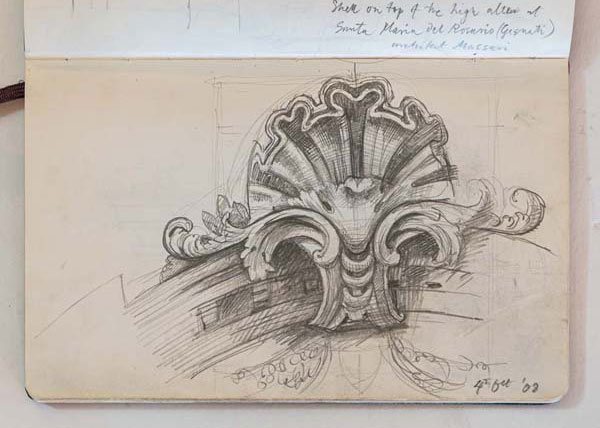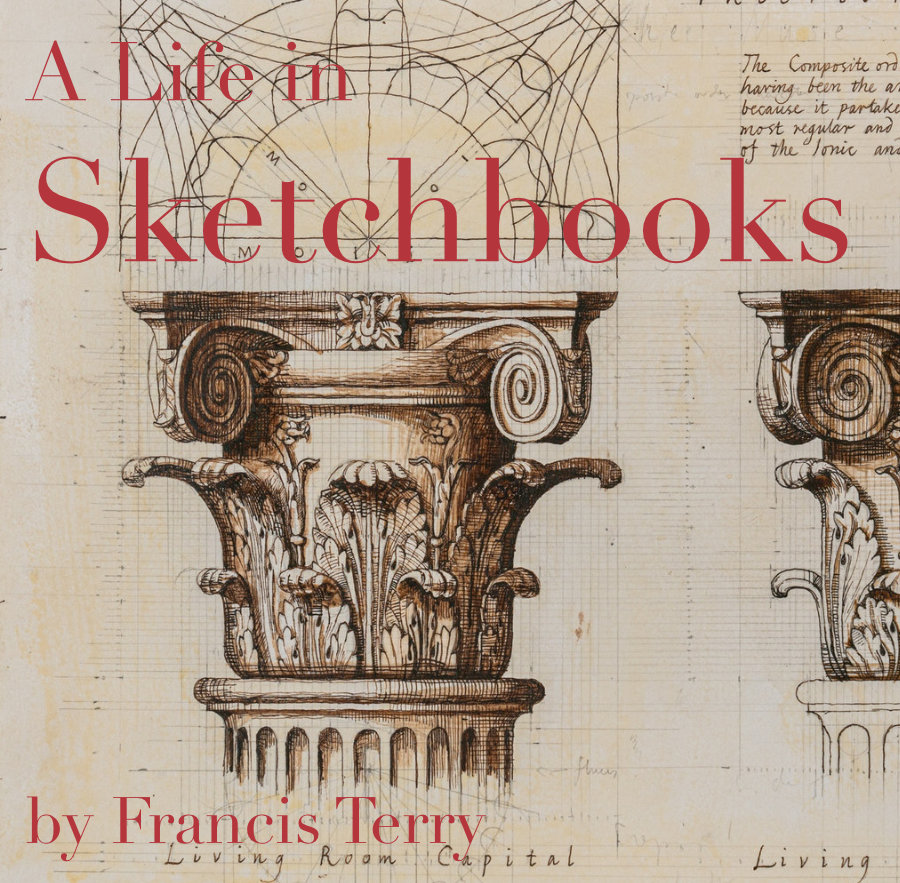A Life in Sketchbooks
I have a collection of my own sketch books going back forty years. These are like a visual diary and they chart my various artistic and architectural interests over the years. Architecture has always been a constant theme but interspersed with drawings of people on trains, ideas for illustrated books, stage sets, life drawings, preliminary sketches for paintings and the occasional shopping list.
My earliest sketch books were canvas bound bought from Senelier’s on Quai Voltaire, Paris. These were given to me by my father and I filled them with a variety of subjects ranging from still-lifes, to pop stars to surrealist compositions - I loved Salvador Dali in those days. There are quite a few watercolours of classical buildings in Italy. My father and I regularly sketched together, and I have written about this previously which can be seen here. I had a technique for these watercolours starting with pencil, then ink then watercolour.
This was the time when I really learnt to draw, at the beginning of the ‘80 my drawings were perhaps charming if a little naive. Over the course of the decade this transformed into my mature style which is still how I draw – more or less. Some of my sketchbooks are partly diaries. They are unbearably self-conscious, but here I am writing a blog about it decades later - start as you mean to go on, I suppose.
In the late ‘80 I had a sketchbook with a marbled cover, this I imagine was bought in Venice where shops full of marbled knickknacks are on every street corner. The first sketches in this book are watercolours - unsurprisingly of Venice. I was by now moving away from my tried and tested pen and ink with watercolour technique and starting to use watercolour by itself.
Later in this book there are pen and ink lecture notes from my first year at Cambridge. I must have written these before I had made any friends and happily this swottyness was soon abandoned. Despite the acres of hours wasted studying architecture, our first-year lecture course was excellent and gave me a basic knowledge of the whole history of European architecture.
In ‘91 I had a year off after my graduation and went to live in Rome for several months, staying at the British School. I spent days drawing sculpture and architecture which was a blissful existence. One of my preferred places was the Villa Borghese which was only a short walk from the British School, it was also very quiet and importantly - free, unlike a lot of galleries in Rome. I spent days or more like weeks sketching the amazing collection of Bernini’s sculpture. When not there, I wondered around Rome sketching and measuring details that caught my eye.
Also, when I lived in Rome a friend from Rhode Island School of Design made me two beautiful sketch books from scratch. They both had a Japanese binding so that each page was an independent sheet rather than having the pages folded in half like a conventional book. One of these books I promptly lost but the other I still have, and it went everywhere with me, including Sicily, India and Washington D.C.
In the mid-90s I rented a studio which I used for painting in my spare time. At that time, I kept a sketch book in my studio and used it to try out ideas for paintings and compositions. Although these books contain some of the worst drawings, they were a means to an end, and this is probably the most authentic type of sketch book. This approach was probably influenced by an exhibition of Picasso’s sketch books at the Royal Academy which I saw many years ago. On his death, Picasso left some 175 sketchbooks spanning over 60 years, their pages filled with drawings of varying quality which were a testament to his extraordinary talent. It was fascinating seeing these sketches showing his working method and experiments from every period of his life. These drawings gave his work a validity that I felt I could not reasonably question and though I am not a fan, you could not deny his creative energy.
Since then I have come to feel that the whole notion of a spontaneous sketch book is a bit fake. Inspiration does not generally take you when you have your sketch book and art materials at hand - like taking a dog for a walk in a town and forgetting to bring poo bags - you never know when the clogs will start turning. Inspiration happens unpredictability and the cliched ‘back of a fag packet’ is a more likely place for an inspired sketch to be wrought.
During the late ‘90s, for a few years I attended a life drawing class on a weekly basis. It was in a friend’s studio and a group of about five or six of us hired a model for a day. We did rapid sketches and long poses, it was intense but very enjoyable. I would come back with dozens of drawing or paintings each time, the drawings below are some quick poses all done on the same day.
As a consequence of having children and reading them bedtime stories, I became fascinated by illustrated books. Doctor Seuss, Maurice Sendak and E.H.Shepard replaced Raphael, Velazquez and Caravaggio in my affections. I completed an illustrated book about the Pied Piper of Hamelin in which instead of stealing all the children, he negotiates a solution with the mayor. Though it was a well-intentioned idea, it was deadly dull. Children aren’t born woke, they have it thrust upon them. They love pain, injustice and horror. Therefore, this sanitized version of the story just didn’t cut it. Had the Piper tortured the children in his cave, I might have had a success on my hands!
Also, around this time I drew some illustrations to nursery rhymes and other similar drawings.
In the early 2000’s I had a sketch book in which I wanted to record the more memorable details I had worked on over the years. These included capitals, ornate ceilings, fireplaces and so on. I made a start but like most big plans that are not essential, they start well but never get finished.
My most recent sketch book is an A5 Moleskin notebook with quite thin cream coloured paper. This has all sorts of things in it, perhaps most significantly two sketches for the Chelsea Barrack counter proposal which successfully derailed Richard Roger’s hideous scheme for that site.
Also, sketches of the capitals at St Paul’s cathedral which I was fortunate to measure when the building was covered in scaffolding.
I took this book to Venice on an office trip in 2008.
At this time I did many tours of Irish houses like Newbridge.
These trips were to help us design Kilboy - there are also sketches of early ideas, including the staircase.
That black sketch book is pretty much the last sketch book I have done, and it is about ten years old. Though I seem to spend more time sketching and painting than I have ever done, I prefer to use loose pieces of paper which are easier to handle, particularly for scanning and photocopying, and so now rarely use sketch books, if at all. As well as this, I find sketchbooks constraining and sometimes intimidating. How hard it is to draw spontaneously in the first page of an expensive book full of blank white pages. Also, if I do a really good sketch, I want to rip it out to give someone as a Christmas present or, conversely, if I do a poor drawing I want to rip it out so no one ever sees it.
The question is, should a sketch book be a bound collection of beautiful drawings, not quite worth framing but worth keeping for their group value or should they be experimental with the many failures kept alongside the few successes? I never really resolved this tension, and significantly nor has the ‘A’ level or GCSE syllabus. When studying art nowadays, instead of drawing still-lifes, pupils have to produce a ‘sketch book’ which tries to ride these opposing horses while fulfilling the criteria of a complex and prescriptive syllabus, a tough challenge for any aspiring artist.
Another problem with sketch books is they can also be easily lost, and it is so much worse losing a whole collection than a single drawing. In a sketch book which had a space marked out in the front for a name and address which I dutifully filled in, there was a further line that said ‘reward if lost’ and a figure with a ‘£’ sign next to it. To avoid friends and colleagues hiding the sketch book and then demanding the ransom, instead of writing a figure I pompously wrote ‘the satisfaction of doing the right thing’. As fate would have it, I did actually leave this sketch book on a train and proving my suspicion that most people are essentially good, I was contacted by a kind stranger a few days later who sent my book back and only wanted to be reimbursed for the postage. That was fortunate, but I did lose one sketch book on a country house tour in Derbyshire which I never found again.
Despite all the drawbacks of sketch books, they do have a compelling allure which is hard to underestimate. There is nothing quite like tactile sensation of leafing through an artist’s sketch book. Paintings in an exhibition can be enjoyed by many people at the same time, but with a sketch book, you, and only you, have the intimate pleasure of hearing the machinery of an artist’s mind whirring away from the comfort of an arm chair. And when the book is shut the music stops, until someone else opens it and the magic starts all over again.
Francis Terry
Francis gave a zoom talk on his sketching through the decades to the Traditional Architects Group recently.
Sketchbooks have always been a critical part of an architect’s work. Francis Terry has a collection of sketchbooks going back forty years to his childhood holidays in Italy sketching architecture with his father, Quinlan Terry. Over the decades he has used sketchbooks as a source of inspiration for his architecture and other artistic ventures ranging from paintings to book illustrations and stage set designs.
In this talk, Francis discusses his work from his various sketchbooks and focus on how these drawings inspired his work.

























































































